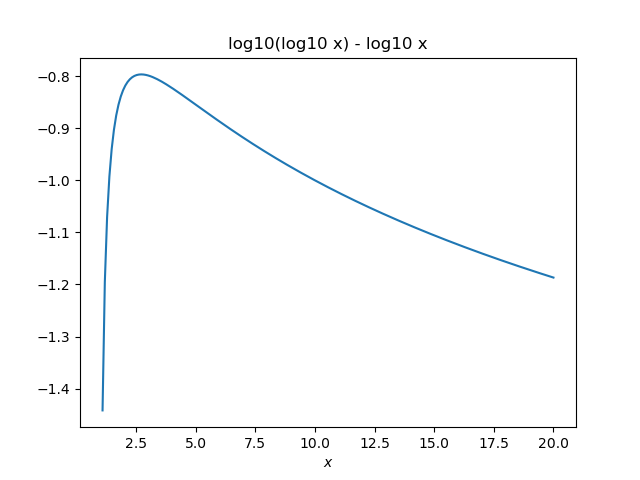I was skimming through a book [1] the other day and saw the following three equations:
log 1.3712885742 = 0.13712885742
log 237.5812087593 = 2.375812087593
log 3550.2601815865 = 3.5502601815865
The sequence of digits is the same on both sides of each equation, except for the position of the decimal point.
The book said “The determination of such numbers has been discussed by Euler and by Professor Tait.” I don’t know who Professor Tait was, but I’ve heard of Euler. I’m curious why Euler was interested in this problem, whether it was idle curiosity inspired by looking up logarithms for some calculation or whether it was part of some larger exploration.
Evidently the logarithms above are taken base 10, and you could formulate the problem as finding solutions to
log10 x = 10k x
for integer k.
For a given k, how many solutions are there?
We could rephrase the question by looking for solutions to
log10(log10 x) − log10 x = k.
A plot shows that the left side is always negative and takes on every negative integer value twice, so there are no solutions for non-negative integers and two solutions for each negative integer.

So, for example, when k = −3 there are two solutions. One is given at the top of the post. The other is x = 1.0023105706421267.
General bases
Would it make much difference if you were to generalize the problem to solving
logb x = bk x
for an arbitrary base b > 1?
Using the fact that
logb x = ln x / ln b
and a little algebra we can formulate the question as looking for solutions to
ln (ln x) − ln x = ln (ln b) + k ln b.
The function on the left hand side takes on the value −1 once and it takes on every other negative integer value twice. The function on the right hand side is positive for positive k, which means no solutions exist in any base b > 1 when k = 0. There is one solution when k = −1 and b = e. Otherwise there are two solutions for negative integers k for each base b.
[1] A Scrap-Book of Elementary Mathematics: Notes, Recreations, Essays by William Frank White, 1908. Available on Project Gutenberg.

My first thought was, in your notation, why do they not give a result where k = 1?
Then I tried to compute it. Of course that’s just log 10 = 1.0, which is uninteresting.
It looks superficially similar to the relation x = tan x, which gives Schrödinger bound state energies of some normalized square well potential. It’s not much, but since you asked.
I’m guessing it’s the Tait of “Thomson and Tait,” authors of a well-known 19th century physics book (before Thomson became Lord Kelvin).
You mentioned this subject before (in particular the 2nd number of today’s post): https://www.johndcook.com/blog/2011/03/07/a-little-math-puzzle/
I concur with Dr. Drang that it is probably Peter Guthrie Tait. His collected scientific papers are avaiable as PDF.
Wow. I totally forgot about that post.
And here’s the original paper by Tait: https://www.cambridge.org/core/services/aop-cambridge-core/content/view/3F688D4A5B1A24F5F102C7FD47942D34/S0013091500001516a.pdf/an_exercise_on_logarithmic_tables.pdf